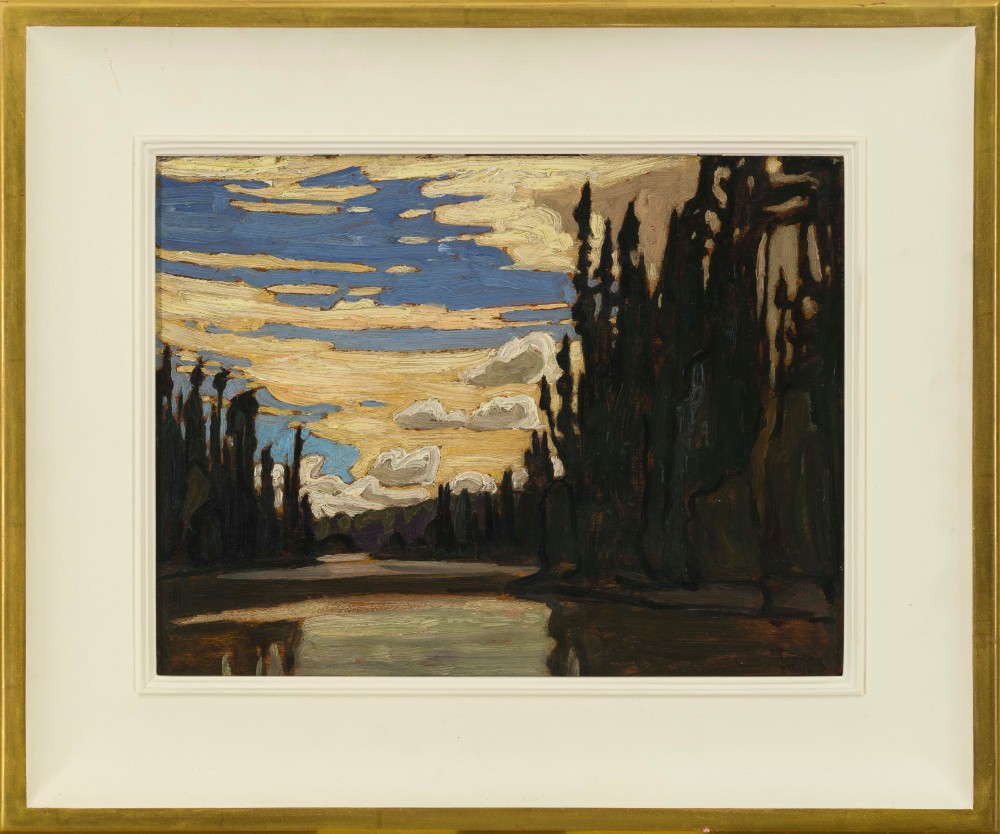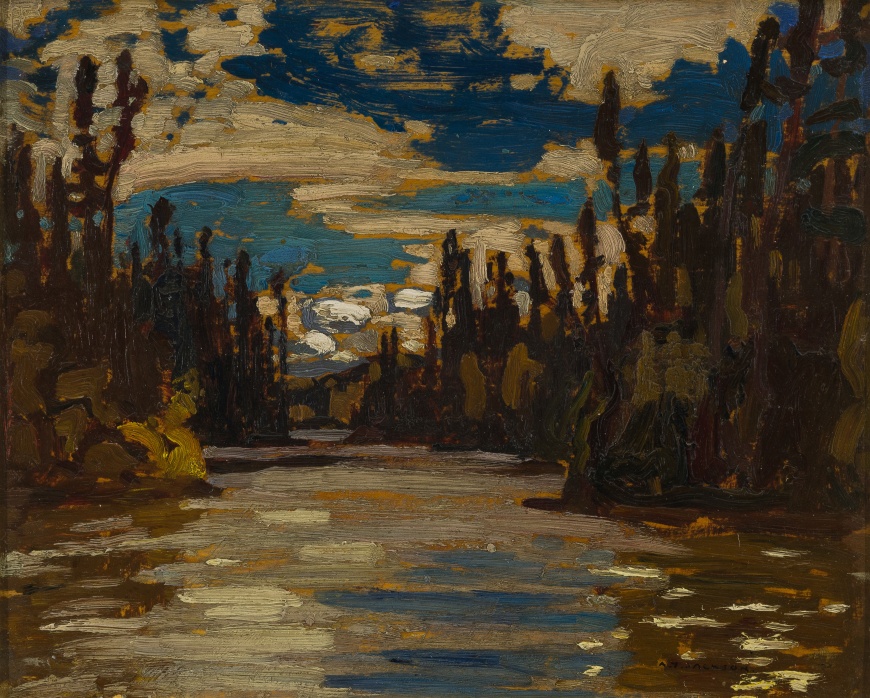22.2 x 27 cm
Inscriptions
signed, ‘A.Y. JACKSON’ (lower right); titled, inscribed and dated in ink by the artist, ‘AN ALGOMA RIVER (in graphite) $40 /1921’ (verso, upper centre)Provenance
Acquired from the artist by a private collection, Ontario
By descent, private collection, Ontario
Heffel Fine Art Auction House, Fine Canadian Art, 23 November 2007, lot 164
Galerie Walter Klinkhoff Inc., Montreal
Property of a Distinguished Montreal Collector
Lawren S. Harris & A.Y. Jackson, Sand Lake, Algoma
by Charles C. Hill
On 22 January 1966, A.Y. Jackson wrote to Thoreau MacDonald about the success of the J.E.H. MacDonald retrospective exhibition that Nancy Robertson had organized for the Art Gallery of Toronto. “The exhibition is attracting a lot of favorable attention. It is well displayed and the catalogue is very helpful. I noticed a couple of errors – not important. ‘Mist Fantasy’ was painted on the Batchawana River – not the Sand which is eighty miles further north.”[1]
It was Lawren Harris who initiated the painting expeditions to Algoma, north of Sault Ste. Marie, when he first travelled there with Dr. James MacCallum, co-financier of the Studio Building, in May 1918. Captivated by the landscape, he returned in September with Dr. MacCallum and fellow artists J.E.H. MacDonald and Frank Johnston. In a refitted work gang boxcar, the group travelled north from the Sault on the Algoma Central Railway to mile 131 at the Agawa Canyon where the car was left on a siding, allowing them to explore and paint. The car was then picked up by a passing train travelling south to allow them to stop at sidings at their request. In late April 1919 the three artists held an exhibition of their Algoma paintings at the Art Museum of Toronto where the paintings were arranged in the sequence of their travels south from Canyon to Hubert, Batchawana, the Montreal River and Mitchell Lake.
Harris returned to Algoma in September 1919 with MacDonald and Johnston, joined this time by A.Y. Jackson, newly discharged from the army. They again travelled in their refitted car to Canyon, stopping at Hubert and Batchawana on their way south.
In May 1920, shortly after the opening of the first exhibition of the Group of Seven, Harris, Dr. MacCallum, Jackson and Arthur Lismer spent ten days in a cabin at Mongoose Lake, east of Batchawana, and in September, Harris, Jackson, Johnston and MacDonald painted around Batchawana and the Montreal Falls. Jackson, Harris and Lismer painted on the Agawa and Montreal Rivers again in May 1921 and it was only in September 1921 that the artists went on to the Sand River at mile 136 ¼, the first train stop north of Agawa on the Algoma Central Railway. All three artists soon exhibited paintings of Sand Lake, and of the Sand River, located at the south end of the lake.
Harris’ Sand Lake, Algoma was sold at Heffel’s auction on 23 November 2007 with the adjacent lot being Jackson’s An Algoma River, both catalogued as having been acquired from the artist by an Ontario collector. Most likely they came from the same collection. The two oil sketches provide us with one of the rare opportunities to see the artists working together at the same site.
On 25 September 1921, Jackson wrote from Sand Lake to Harold Mortimer Lamb, “This is a rainy day so I can restrain my desire to wander into the bush. Harris and I are on our annual autumn sketching trip and will be here on Sand Lake for a couple of weeks and then move on to the north shore Lake Superior. It does not promise to be much of an autumn, very little colour and lots of bad weather but we generally end up with a lot of material.” [2]
The rainy weather and lack of colour are clearly evident in the dark shadows of two sketches. The artists might even have been in the same canoe when they painted these views of the river bordered by dark evergreens. Even the cloud formations are remarkably similar. In Harris’ sketch the eye is carried to the far end of the flat body of water that reflects little of the blue sky while in Jackson’s sketch the distant trees are brought forward and animated by the brown paint. Jackson’s water is more animated, broken up by the dabs of white and modulated colour. Jackson’s is a close-up view while Harris’ is more distant and sombre.
Jackson used the back of his panel to start a composition of trees by the water’s edge that is very similar to his oil sketch A Beaver Lake, dated 1921, and sold at Heffel’s, 28 November 2009, lot 309, and Beaver Lake, Algoma in the McMichael Canadian Art Collection (1968.8.20).
Harris’ sketch served as the basis for a canvas in which he enhanced the sculptural forms of the trees but opened up the stream at the focal point, lightening the distant trees, visually bringing them forward. The canvas retains the sombre silence of the sketch.
Charles C. Hill
Charles C. Hill was Assistant, then Curator of Canadian Art at the National Gallery of Canada from 1972 to 2014. He has organized numerous exhibitions, including Canadian Painting in the Thirties(1975) and The Group of Seven: Art for a Nation (1995), and was co-organizer of Tom Thomson(2002), Emily Carr: New Perspectives on a Canadian Icon (2006) and Artists, Architects, Artisans: Canadian Art 1890-1918. He became a member of the Order of Canada in 2000.
______________________
Footnotes:
[1] Thoreau MacDonald fonds, Library and Archives Canada, Ottawa, MG30 D112 file “Correspondence [1945]-1966, n.d.. On a map of the Algoma Central Railway, Batchewana is at mile 80 and Agawa, just south of Sand Lake, is at mile 131, so Sand Lake is a little more than fifty miles north of Batchewana. To the best of my knowledge, MacDonald never painted on the Sand River.
[2] Harold Mortimer Lamb Papers, Archives, University of New Brunswick (MS 2834). My thanks to Douglas Hunter, author of Jackson’s Wars: A.Y. Jackson, the Birth of the Group of Seven, and the Great War (McGill-Queen’s University Press, 2022) for bringing this fonds to my attention















